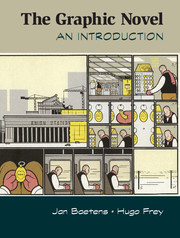1 - Introduction: The Graphic Novel, a Special Type of Comics
Published online by Cambridge University Press: 05 October 2014
Summary
Is there really something like the graphic novel?
For good or ill, there are famous quotations that are frequently repeated when discussing the graphic novel. They are valued because they come from two of the key protagonists whose works from the mid-1980s were so influential in the concept gaining in popularity: Art Spiegelman, the creator of Maus, and Alan Moore, the scriptwriter of Watchmen. Both are negative about the neologism that was being employed to describe the longer-length and adult-themed comics with which they were increasingly associated, although their roots were with underground comix in the United States and United Kingdom, respectively. Spiegelman’s remarks were first published in Print magazine in 1988, and it was here that he suggested that “graphic novel” was an unhelpful term:
The latest wrinkle in the comic book’s evolution has been the so-called “graphic novel.” In 1986, Frank Miller’s Batman: The Dark Knight Returns, a full-length trade paperback detailing the adventures of the superhero as a violent, aging vigilante, and my own MAUS, A Survivor’s Tale both met with commercial success in bookstores. They were dubbed graphic novels in a bid for social acceptability (Personally, I always thought Nathaniel West’s The Day of the Locust was an extraordinarily graphic novel, and that what I did was ... comix.) What has followed is a spate of well-dressed comic books finding their way into legitimate bookshops. Sadly, a number of them are no more than pedestrian comic books in glossy wrappings, and the whole genre, good and bad may find itself once again banished to the speciality shops....
And more briefly, but in a similar vein, these are the views of Alan Moore:
You could just about call Maus a novel, you could probably just about call Watchmen a novel, in terms of density, structure, size, scale, seriousness of theme, stuff like that. The problem is that “graphic novel” just came to mean “expensive comic book” ... it doesn’t really matter much what they’re called but it’s not a term that I’m very comfortable with.
- Type
- Chapter
- Information
- The Graphic NovelAn Introduction, pp. 1 - 24Publisher: Cambridge University PressPrint publication year: 2014



